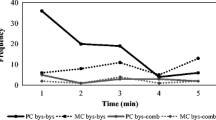Summary
-
1.
After agonistic interactions among chimpanzees, former opponents often come into non-violent body contact. The present paper gives a quantitative description of such contacts among the chimpanzees of a large semi-free-living colony at the Arnhem Zoo, in order to establish whether these post-conflict contacts are of a specific nature.
-
2.
Our data indicate that former opponents preferentially make body contact with each other rather than with third partners. They tend to contact each other shortly after the conflict and show special behaviour patterns during these first contacts. Data on contacts of the aggressed party with third animals indicate that such contacts are characterized by the same special behaviour patterns as first interopponent contacts. These patterns are: ‘kiss’, ‘embrace’, ‘hold-out-hand’, ‘submissive vocalization’ and ‘touch’.
-
3.
Such interactions apparently serve an important socially homeostatic function and we termed them ‘reconciliation’ (i.e. contact between former opponents) and ‘consolation’ (i.e. contact of the aggressed party with a third animal). According to our data, ‘kissing’ is characteristic of reconciliation and ‘embracing’ of consolation.
Similar content being viewed by others
References
Blurton-Jones, N.G., Trollope, J.: Social behaviour of stump-tailed macaques in captivity. Primates 9, 365–394 (1968)
Ehrlich, A., Musicant, A.: Social and individual behaviors in captive slow lorises. Behaviour 60, 195–220 (1977)
Eibl-Eibesfeldt, I.: Der vorprogrammierte Mensch. München: Deutscher Taschenbuch Verlag 1976
Ellefson, J.O.: Territorial behavior in the common white-handed gibbon, Hylobates lar. In: Primates; studies in adaptation and variability. Jay, P. (ed.), pp. 180–199, New York: Holt 1968
Everitt, B.S.: The analysis of contingency tables. New York: Wiley 1977
Hooff, J.A.R.A.M. van. The Arnhem Zoo chimpanzee consortium: An attempt to create an ecologically and socially acceptable habitat. Int. Zoo Yearb. 13 195–205 (1973)
Hooff, J.A.R.A.M. van: A structural analysis of the social behaviour of a semi-captive group of chimpanzees. In: Social communication and movement. Cranach, M. von, Vine, I. (eds.), pp. 75–162. London: Academic 1974
Kaplan, E.L., Meier, P.: Nonparametric estimation from incomplete observations. Am. Stat. Assoc. J. 53, 457–481 (1958)
Kummer, H.: Soziales Verhalten einer Mantelpavian-Gruppe. Bern, Stuttgart: Verlag Hans Huber 1957
Lawick-Goodall, J. van: A preliminary report on expressive movements and communication in the Gombe Stream chimpanzees. In: Primates; studies in adaptation and variability. Jay, P. (ed.), pp. 313–374. New York: Holt 1968a
Lawick-Goodall, J. van: Behaviour of free-living chimpanzees of the Gombe Stream Area. Anim. Behav. Monogr. 3, 161–311 (1968b)
Lindburg, D.G.: Grooming behavior as a regulator of social interactions in rhesus, monkeys. In: Behavioral regulators of behavior in primates. Carpenter, C. (ed.), pp. 85–105. Lewisburg, PA, USA: Bucknell Univ. 1973
Marler, P.: On animal aggression; the roles of strangeness and familiarity. Am. Psychol. 31, 239–246 (1976)
Mason, W.A.: Sociability and social organization in monkeys and apes. In: Advances in experimental social psychology, Vol. 1. Berkowitz, L. (ed.), pp. 277–305. New York: Academic 1964
Nishida, T.: Social behavior and relationship among wild chimpanzees of the Mahali Mountains. Primates 11, 47–87 (1970)
Okano, T., Asami, C., Haruki, Y., Sasaki, M., Itoigawa, N., Shinohara, S., Tsuzuki, T.: Social relations in a chimpanzee colony. In: Behavioral regulators of behavior in primates. Carpenter, C. (ed.), pp. 85–105. Lewisburg, PA, USA: Bucknell Univ. 1973
Pfeffer, P.: Le mouflon de Corse (Ovis ammon musimom); position systématique, écologie et éthologie comparées. Mammalia 31 [Suppl.] (1967)
Poirier, F.E.: Dominance structure of the Nilgiri langer (Presbytis johnii) of South Inida. Folia Primatol. 12, 161–186 (1970)
Rasa, O.A.E.: The ethology and sociology of the Dwarf Mongoose (Helogale undulata rufula). Z. Tierpsychol. 43, 337–406 (1977)
Rijksen, H.D.: A field study on Sumatran Orang Utans (Pongo pygmaeus); ecology, behaviour and conservation. Meded. Landbouwhogesch. Wageningen 78-2,421 (1978)
Sade, D.S.: Some aspects of parent-offspring and sibling relations in a group of rhesus monkeys, with a discussion of grooming. Am. J. Phys. Anthropol. 23, 1–117 (1965)
Seyfarth, R.M.: Social relationships among adult female baboons. Anim. Behav. 24, 917–938 (1976)
Waal, F.B.M. de: Exploitative and familiarity-dependent support strategies in a colony of semi-free living chimpanzees. Behaviour 66, 268–312 (1978)
Author information
Authors and Affiliations
Rights and permissions
About this article
Cite this article
de Waal, F.B.M., van Roosmalen, A. Reconciliation and consolation among chimpanzees. Behav Ecol Sociobiol 5, 55–66 (1979). https://doi.org/10.1007/BF00302695
Received:
Issue Date:
DOI: https://doi.org/10.1007/BF00302695




